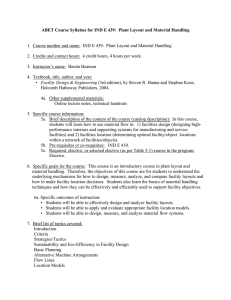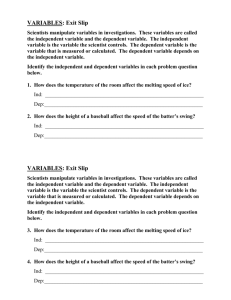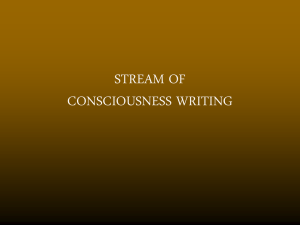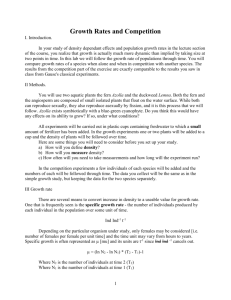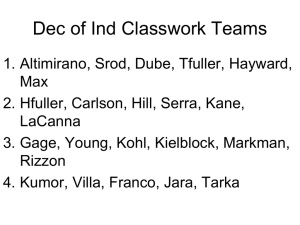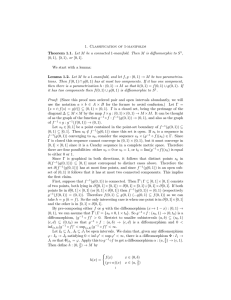Homework 3 ∗
advertisement
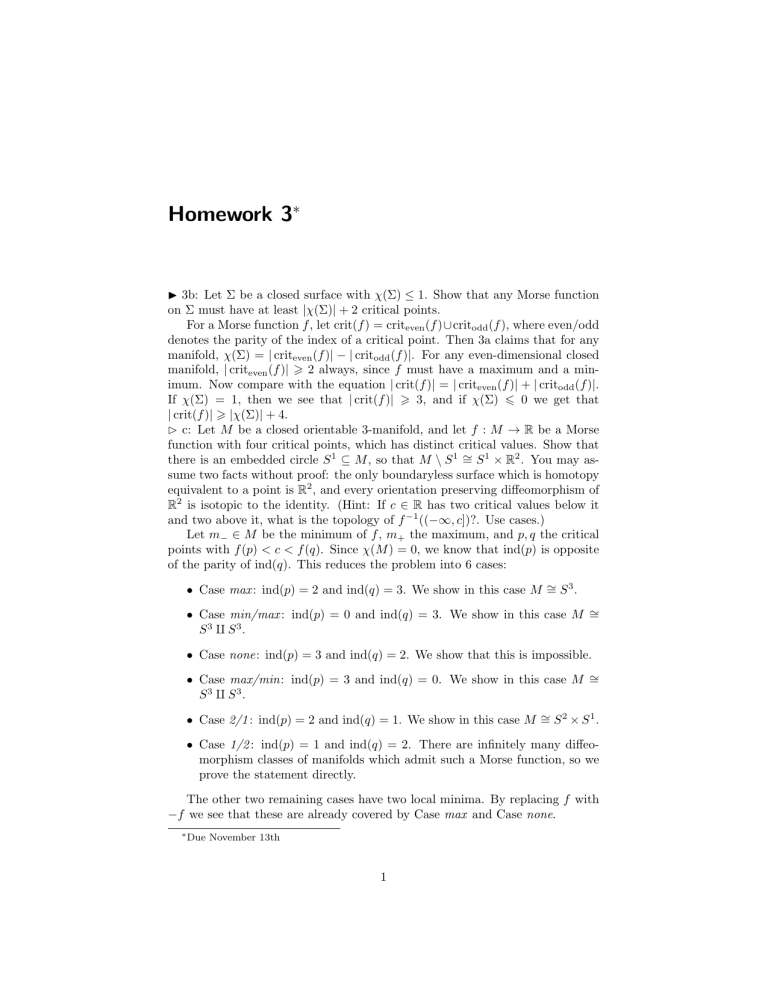
Homework 3∗
I 3b: Let Σ be a closed surface with χ(Σ) ≤ 1. Show that any Morse function
on Σ must have at least |χ(Σ)| + 2 critical points.
For a Morse function f , let crit(f ) = criteven (f )∪critodd (f ), where even/odd
denotes the parity of the index of a critical point. Then 3a claims that for any
manifold, χ(Σ) = | criteven (f )| − | critodd (f )|. For any even-dimensional closed
manifold, | criteven (f )| > 2 always, since f must have a maximum and a minimum. Now compare with the equation | crit(f )| = | criteven (f )| + | critodd (f )|.
If χ(Σ) = 1, then we see that | crit(f )| > 3, and if χ(Σ) 6 0 we get that
| crit(f )| > |χ(Σ)| + 4.
B c: Let M be a closed orientable 3-manifold, and let f : M → R be a Morse
function with four critical points, which has distinct critical values. Show that
there is an embedded circle S 1 ⊆ M , so that M \ S 1 ∼
= S 1 × R2 . You may assume two facts without proof: the only boundaryless surface which is homotopy
equivalent to a point is R2 , and every orientation preserving diffeomorphism of
R2 is isotopic to the identity. (Hint: If c ∈ R has two critical values below it
and two above it, what is the topology of f −1 ((−∞, c])?. Use cases.)
Let m− ∈ M be the minimum of f , m+ the maximum, and p, q the critical
points with f (p) < c < f (q). Since χ(M ) = 0, we know that ind(p) is opposite
of the parity of ind(q). This reduces the problem into 6 cases:
• Case max : ind(p) = 2 and ind(q) = 3. We show in this case M ∼
= S3.
• Case min/max : ind(p) = 0 and ind(q) = 3. We show in this case M ∼
=
S3 q S3.
• Case none: ind(p) = 3 and ind(q) = 2. We show that this is impossible.
• Case max/min: ind(p) = 3 and ind(q) = 0. We show in this case M ∼
=
S3 q S3.
• Case 2/1 : ind(p) = 2 and ind(q) = 1. We show in this case M ∼
= S2 × S1.
• Case 1/2 : ind(p) = 1 and ind(q) = 2. There are infinitely many diffeomorphism classes of manifolds which admit such a Morse function, so we
prove the statement directly.
The other two remaining cases have two local minima. By replacing f with
−f we see that these are already covered by Case max and Case none.
∗ Due
November 13th
1
2
In every case, the manifolds f −1 (−∞, f (p)−ε] and f −1 [f (q)+ε, ∞) are both
diffeomorphic to the closed ball B 3 . Indeed, f −1 (−∞, f (m− ) + ε] is diffeomorphic to B 3 by the standard neighborhood of critical points, and f −1 [f (m− ) +
ε, f (p) − ε] has no critical points and is therefore diffeomorphic to S 2 × I. Since
S 2 has a unique orientation preserving diffeomorphism up to isotopy, we see
that f −1 (∞, f (p) − ε] ∼
= B3.
= B 3 ∪S 2 S 2 × I ∼
We show that, if ind(p) = 2, then f −1 (−∞, c] ∼
= S 2 × I. We know that
−1
3
2
f (−∞, c] deformation retracts onto B ∪ D , but in fact we know more: that
f −1 (−∞, c] is diffeomorphic to B 3 ∪ U , where U is a small closed neighborhood
of D2 . U ∼
= S 1 × I. Up to isotopy, there is a unique
= D2 × I, so U ∩ ∂B 3 ∼
1
2 ∼
embedding of S × I into S = ∂B 3 (Jordan curve theorem). Therefore the
diffeomorphism type of the gluing is unique. Since S 2 × I is such a gluing
(taking S 1 × I as a neighborhood of the equator) this completes the claim.
Case max : Since M = f −1 (−∞, c] ∪f −1 (c) f −1 [c, ∞) ∼
= S 2 × I ∪∂ (B 3 q B 3 ),
and since there is a unique orientation preserving diffeomorphism of S 2 , the
only possibility if M ∼
= S3.
Case min/max : Here M = f −1 (−∞, c] ∪f −1 (c) f −1 [c, ∞) ∼
= (B 3 q B 3 ) ∪∂
3
3 ∼ 3
3
(B q B ) = S q S .
Case none: f −1 (−∞, f (p) + ε] = f −1 (−∞, f (p) − ε] ∪f −1 (f (p)−ε) f −1 [f (p) −
ε, f (p) + ε] ∼
= B 3 ∪S 2 B 3 ∼
= S 3 . Therefore f −1 (f (p) + ε) = ∂f −1 (−∞, f (p) + ε] ∼
=
3
−1
∂S = ∅. Thus f [f (p) + ε, ∞) is a closed manifold, but f has no minimum
on this manifold.
Case max/min: Just as in the previous case we see that f −1 (−∞, f (p)+ε] ∼
=
3
S . But now f −1 [f (p) + ε, ∞) is a closed manifold, and f has two critical points
on it, a minimum and a maximum. Therefore M ∼
= S3 q S3.
Case 2/1 : By the claim above the cases we know f −1 (−∞, c]congS 2 × I.
−1
f [c, ∞) ∼
= S 2 × I as well, since we can replace f with −f and apply the same
claim. Therefore M ∼
= S 2 × I ∪S 2 qS 2 S 2 × I ∼
= S 2 × (I ∪∂ I) = S 2 × S 1 .
−1
Case 1/2 : We first show that f (−∞, c] ∼
= S 1 × D2 . We know that
−1
3
f (−∞, c] deformation retracts onto B ∪ I, but more than that, we know
that it is diffeomorphic to B 3 ∪ U , where U is a small closed neighborhood of
I ⊆ M . Therefore U ∼
= I × D2 , so U ∩ ∂B 3 ∼
= D2 q D2 . Since up to isotopy
there is a unique way to embed two disks into S 2 in an orientation preserving
manner, we see that this gluing is unique. Since S 1 ×D2 is such a gluing (taking
D2 q D2 to be neighborhoods of the poles), we completed the claim.
But then also f −1 [c, ∞) ∼
= S 1 × D2 , since the critical point data is the same
after being turned upside down. Therefore M ∼
= S 1 ×D2 ∪T 2 S 1 ×D2 . Removing
1
the curve S ×{0} in one of the factors leaves M \S 1 ∼
= S 1 ×D2 ∪T 2 S 1 ×(D2 \{0}).
2
Any diffeomorphism of T extends to a diffeomorphism of S 1 × D2 \ {0} =
T 2 ×[0, 1) (obviously). Therefore M \S 1 ∼
= S 1 ×D2 ∪T 2 T 2 ×[0, 1) ∼
= S 1 ×Int(D2 ).
3
It remains to reach the conclusion for the manifolds S and S 2 × S 1 . For
3
S = {(z, w) ∈ C2 ; |z|2 + |w|2 = 1}, we can let S 1 = {w = 0} and then
S 3 \ S 1 = {|z|2 < 1; |w|2 = 1 − |z|2 } ∼
= S 1 × Int(D2 ). For the case S 2 × S 1
1
simply remove {point} × S .
B d: Give an example of a closed 3-manifold M , so that any Morse function on
M has at least 6 critical points.
3
Let M = T 3 . Since χ(T 3 ) = 0 we know that any Morse function has an even
number of critical points, so it suffices to show that T 3 \ S 1 is not diffeomorphic
to S 1 × R2 for any S 1 ⊆ T 3 .
In T 3 , let α = {point} × {point} × S 1 , β = S 1 × {point} × {point}, B =
{point}×T 2 , and A = T 2 ×{point}. Then [α]·[A] = ±1, [α]·[B] = 0, [β]·[A] = 0,
and [β] · [B] = ±1. Since intersection product is a homotopy invariant, it follows
that neither α nor β is homotopic to a constant, and they are not homotopic to
each other. Furthermore the only maps f : S 1 → α, g : S 1 → β so that f and
g are homotopic are degree zero, since [f ] · [A] = ± deg(f ) and etc. (we drop
composition with the inclusion from the notation).
Now let S 1 ⊆ T 3 be an arbitrary embedding. We can assume that α and β
are disjoint from S 1 by Sard’s theorem. In S 1 × R2 , every map h : S 1 → S 1 × R2
is homotopic to a map e
h : S 1 → S 1 × {0} (just compose with the deformation
retraction). Since α and β are never homotopic in T 3 even after composing with
a function S 1 → S 1 , they cannot be homotopic in T 3 \ S 1 either, so we see that
T 3 \ S 1 is not diffeomorphic to S 1 × R2 .
